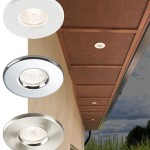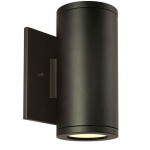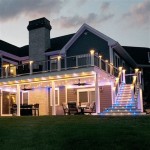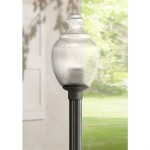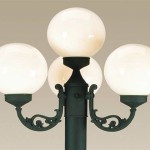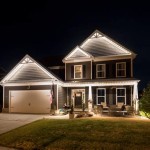Illuminating Your Landscape: A Comprehensive Guide to 12V Outdoor Lighting
Outdoor lighting enhances the aesthetics, security, and functionality of any property. Among the various options available, 12V outdoor lighting systems offer a compelling balance of safety, efficiency, and ease of installation, making them a popular choice for homeowners and landscape professionals alike. This article will delve into the intricacies of 12V outdoor lighting, exploring its advantages, components, installation procedures, and maintenance requirements.
Low-voltage lighting operates on a reduced electrical current, typically 12 volts, in contrast to the standard 120V or 240V systems found in residential electrical wiring. This lower voltage significantly reduces the risk of electrical shock, making it a safer option for outdoor environments where exposure to moisture and physical contact is more likely. The use of a transformer to step down the voltage from the main electrical supply is a key characteristic of these systems.
The aesthetic appeal of well-placed outdoor lighting cannot be overstated. It creates ambiance, highlights architectural features, and accentuates landscaping elements. Beyond aesthetics, outdoor lighting plays a crucial role in enhancing safety and security. Properly illuminated pathways, steps, and entryways minimize the risk of accidents, while strategically placed lights can deter intruders. Furthermore, outdoor lighting extends the usability of outdoor spaces, enabling comfortable enjoyment of patios, decks, and gardens even after dark.
Key Point 1: Advantages of 12V Outdoor Lighting Systems
Several advantages contribute to the popularity of 12V outdoor lighting systems. These advantages encompass safety, ease of installation, energy efficiency, and flexibility in design.
Safety: As previously mentioned, the reduced voltage of 12V systems significantly minimizes the risk of electrical shock. This is particularly crucial in outdoor settings where exposure to water and moisture is common. The lower voltage also reduces the potential for fires caused by electrical faults.
Ease of Installation: 12V systems are generally easier to install compared to line-voltage systems. Due to the lower voltage, many installations do not require the expertise of a licensed electrician. The wiring can typically be buried shallowly without the need for conduit in many jurisdictions, simplifying the installation process. However, it is always recommended to consult local electrical codes and regulations before undertaking any electrical work.
Energy Efficiency: Modern 12V outdoor lighting systems often utilize LED (Light Emitting Diode) technology. LEDs are significantly more energy-efficient than traditional incandescent or halogen bulbs. They consume less power to produce the same amount of light, resulting in lower energy bills and a reduced environmental impact. The long lifespan of LEDs also reduces the frequency of bulb replacements, further minimizing maintenance costs.
Flexibility in Design: The low-voltage nature of these systems allows for greater flexibility in design and placement of fixtures. The wiring is less bulky and easier to conceal, enabling discreet and aesthetically pleasing installations. Moreover, the availability of a wide range of fixture styles and designs caters to diverse landscaping and architectural preferences.
Cost-Effectiveness: While the initial investment in a 12V system might appear slightly higher than traditional options, the long-term cost savings associated with energy efficiency and reduced maintenance often outweigh the initial expense. The extended lifespan of LED bulbs and the lower energy consumption translate into significant savings over the lifespan of the system.
Key Point 2: Components of a 12V Outdoor Lighting System
A typical 12V outdoor lighting system comprises several key components that work together to provide illumination. Understanding the function of each component is essential for proper installation and maintenance.
Transformer: The transformer is the heart of the system, responsible for stepping down the standard household voltage (120V or 240V) to 12V. It is typically housed in a weatherproof enclosure and should be sized appropriately based on the total wattage of all the connected fixtures. Overloading the transformer can lead to overheating and premature failure. Transformers come in various types, including magnetic and electronic, each with its own advantages and disadvantages. Electronic transformers are generally more compact and energy-efficient, while magnetic transformers are known for their durability. Choosing the right transformer is crucial for the overall performance and longevity of the system.
Lighting Fixtures: A wide variety of 12V lighting fixtures are available to suit different applications and aesthetic preferences. These include path lights, spotlights, floodlights, well lights, deck lights, and string lights. Each type of fixture is designed to provide specific types of illumination. Path lights, for example, are used to illuminate walkways and driveways, while spotlights are used to highlight specific objects or architectural features. The choice of fixture material, such as brass, copper, or aluminum, depends on the desired aesthetics and the level of corrosion resistance required. LED bulbs are the most common light source used in these fixtures due to their energy efficiency and long lifespan.
Wiring: The wiring used in 12V outdoor lighting systems is typically low-voltage landscape lighting wire, which is designed to withstand the harsh outdoor environment. The wire gauge (thickness) must be appropriate for the length of the wire run and the total wattage of the fixtures connected to it. Undersized wiring can lead to voltage drop, resulting in dim or flickering lights. The wiring is typically buried shallowly, often without the need for conduit, depending on local regulations. Direct burial wire is specifically designed for this purpose and is resistant to moisture and corrosion.
Connectors: Connectors are used to join the lighting fixtures to the main wiring. Weatherproof connectors are essential to prevent corrosion and ensure reliable electrical connections. A variety of connector types are available, including crimp connectors, wire nuts, and gel-filled connectors. Gel-filled connectors offer superior protection against moisture and are recommended for use in damp or wet environments.
Timer/Photocell (Optional): A timer or photocell can be used to automate the operation of the lighting system. A timer allows the lights to be turned on and off at pre-set times, while a photocell automatically turns the lights on at dusk and off at dawn. These devices enhance convenience and energy efficiency by ensuring that the lights are only on when needed.
Key Point 3: Installation and Maintenance of 12V Outdoor Lighting
Proper installation and regular maintenance are essential for ensuring the optimal performance and longevity of a 12V outdoor lighting system.
Installation Process: The installation process typically involves several steps. First, the location of the fixtures and the transformer must be carefully planned. The transformer should be located in a protected area, such as a garage or shed, and close to a GFCI-protected electrical outlet. Next, the wiring is laid out and connected to the transformer and the fixtures. The fixtures are then positioned and secured in place. Finally, the system is tested to ensure that all the lights are working properly. It is crucial to follow the manufacturer's instructions carefully and to adhere to local electrical codes and regulations.
Voltage Drop Considerations: Voltage drop is a common issue in low-voltage lighting systems. It occurs when the voltage decreases along the length of the wire run, resulting in dim or flickering lights at the end of the run. To minimize voltage drop, use appropriate wire gauge, keep wire runs as short as possible, and distribute the load evenly among the fixtures. Voltage drop calculators are available online to help determine the appropriate wire gauge for a given application. Consider splitting the system into multiple zones, each with its own transformer feed, to further reduce voltage drop.
Wire Burial and Protection: While direct burial wire is designed to withstand moisture and corrosion, it is still important to bury the wiring properly. The wiring should be buried at least 6 inches deep to protect it from physical damage. Avoid running the wiring through areas that are frequently disturbed, such as gardens or flowerbeds. Consider using conduit in areas where the wiring is exposed to heavy traffic or potential damage.
Maintenance Procedures: Regular maintenance is essential for keeping the system in good working order. This includes cleaning the fixtures periodically to remove dirt and debris, checking the wiring and connectors for corrosion or damage, and replacing bulbs as needed. Inspect the transformer for signs of overheating or malfunction. Tighten any loose connections and repair any damaged wiring promptly. Trimming vegetation that obstructs the light output from the fixtures is also an important maintenance task.
Troubleshooting Common Issues: Several common issues can arise with 12V outdoor lighting systems. These include blown bulbs, tripped breakers, and corroded connections. Start by checking the bulbs and replacing any that are blown. If the breaker is tripped, reset it and investigate the cause of the overload. Check the wiring and connectors for signs of corrosion or damage and replace any that are faulty. If the problem persists, consult a qualified electrician.
Upgrading and Expanding the System: As landscaping needs evolve, the lighting system can be upgraded or expanded. Adding new fixtures or replacing existing ones with more energy-efficient models is a simple way to enhance the system. When expanding the system, ensure that the transformer is adequately sized to handle the additional load. Consider using a programmable timer or photocell to automate the operation of the expanded system.

Low Voltage Outdoor Garden Lights From In Lite Lumena Konstsmide

Techmar Smart Round 40 Decorative Light

Techmar Lunia 12v Plug Play Led Garden Post Light Kits

Techmar Larix Garden Led Post Light Kit

Techmar Laurus 12v Plug Play Garden Post Light Bundle 10 Kit

Antique Brass Garden Led Spot Light With Wall Mount 12v 4w 400 Lumens From Landscape Lighting

12 Volt Vs 240 Outdoor Lights Part 3 Garden Landscape Lighting

12v Solar Lighting System Durasol Low Voltage Outdoor Kit

Techmar Larix 12v Plug Play Led Garden Lights Bundle 8 Light Kit

Techmar Deimos White 12v Led Garden Wall Light
Related Posts
